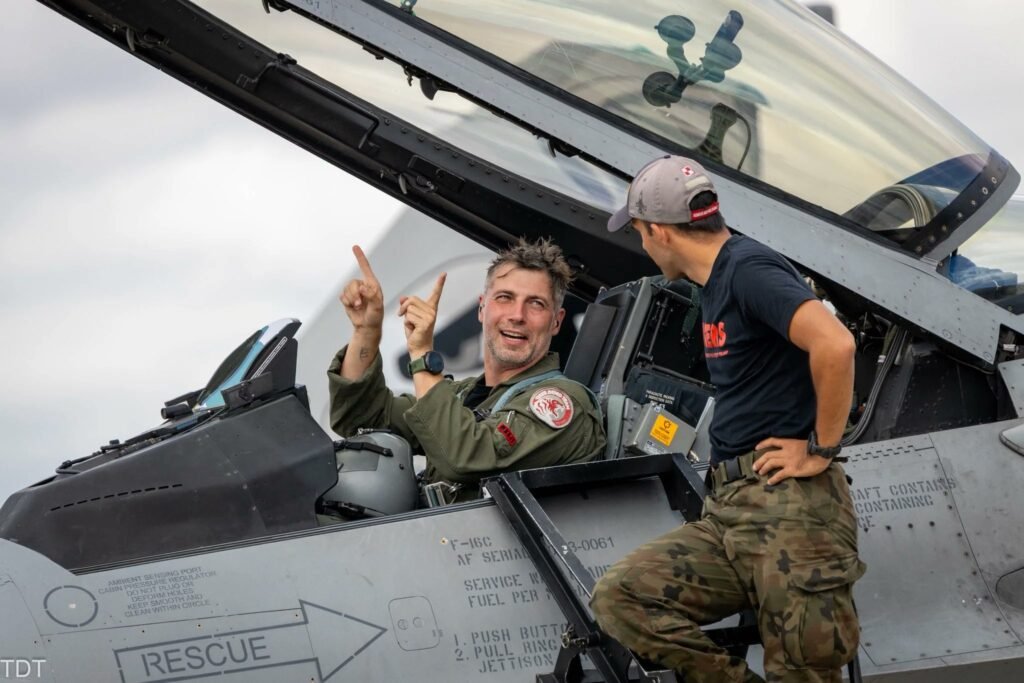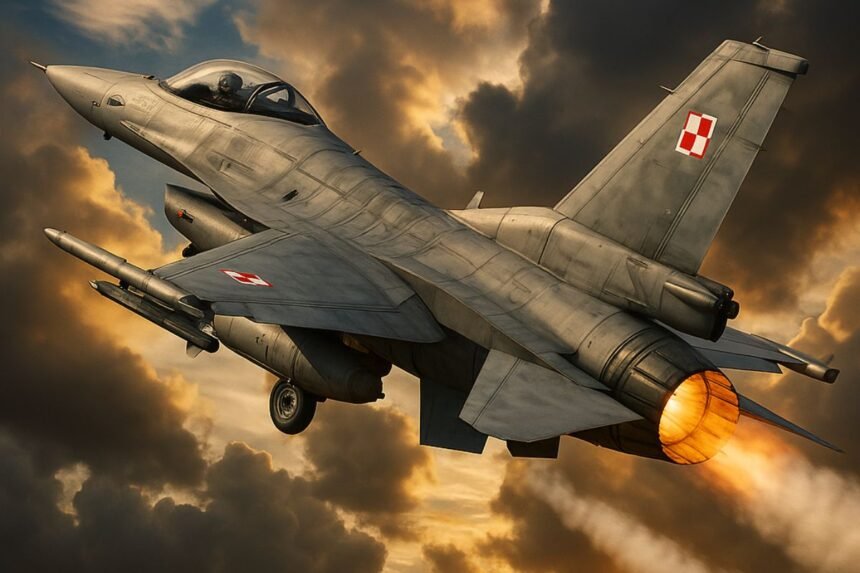A devastating accident during airshow preparations in Poland has resulted in the death of a highly decorated military pilot, marking the first F-16 crash in the country’s aviation history and forcing the cancellation of one of Europe’s largest aviation events.
The Tragic Incident
On August 28, 2025, at approximately 7:25 PM local time, a Polish Air Force F-16 Fighting Falcon crashed during rehearsal preparations at Radom Air Base, approximately 100 kilometers south of Warsaw. The aircraft, performing a barrel roll aerobatic maneuver as part of the F-16 Tiger Demo Team’s routine, suddenly lost control and plummeted to the runway in a catastrophic descent.
Dramatic footage captured by spectators shows the fighter jet nose-diving toward the ground before erupting into a massive fireball upon impact. The aircraft skidded along the runway while engulfed in flames, causing significant damage to the airfield surface. Emergency services responded immediately, but the pilot was pronounced dead at the scene.
The Fallen Hero

The pilot has been identified as Major Maciej “SLAB” Krakowian, a distinguished flying ace and leader of the prestigious F-16 Tiger Demo Team. Krakowian was considered one of Poland’s most experienced and respected display pilots, with over 1,000 hours of F-16 flight time and extensive combat experience.
Just weeks before the fatal crash, Major Krakowian had received the “As the Crow Flies” Trophy at the 2025 Royal International Air Tattoo in the United Kingdom, recognized for delivering the “best overall flying demonstration” at the world’s largest military airshow. He was also a graduate of both the Polish Aviation Training Institute in Dęblin and the United States Air Force Academy in Colorado Springs.
The 31-year-old pilot served as an instructor at the 31st Tactical Air Base near Poznań, where the Tiger Demo Team is stationed. His call sign “SLAB” was adopted directly from English, and he had assumed leadership of the demonstration team in 2023.

Official Response and National Mourning
Poland’s Deputy Prime Minister and Defense Minister Władysław Kosiniak-Kamysz rushed to the crash site and confirmed the pilot’s death in an emotional statement. “In the F-16 plane crash, a Polish Army pilot died – an officer who always served the Fatherland with dedication and great courage. I pay tribute to His memory,” he wrote on social media platform X.
Prime Minister Donald Tusk also expressed profound condolences, stating: “In the F-16 plane crash, a Polish pilot was killed. Rest in peace! To the family and loved ones, I offer my deepest condolences from the bottom of my heart”.
The General Command of the Polish Armed Forces emphasized that no bystanders were injured in the incident, though the crash caused extensive damage to the runway infrastructure.
Immediate Consequences
The tragic accident forced the immediate cancellation of the Radom Air Show 2025, which was scheduled for August 30-31. The biannual event, considered Poland’s most popular aviation celebration, was expected to attract approximately 180,000 spectators and featured aircraft from across Europe and beyond.
This marks the first F-16 crash in Polish aviation history, making it a particularly significant loss for the nation’s air force. The incident occurred on Polish Aviation Day, transforming what should have been a day of national pride into one of profound grief.
Technical and Safety Context
The crash involved an F-16C Block 52+ aircraft from the 31st Tactical Air Base near Poznań. Poland operates a fleet of 48 F-16C/D Block 52+ fighters, which were delivered between 2006 and 2008 under the Peace Sky program. These aircraft represent some of the most advanced F-16 variants in European service, equipped with Pratt & Whitney F-100-229 engines and sophisticated avionics suites.
Preliminary reports suggest the pilot was unable to eject from the aircraft before impact. The exact cause of the crash remains under investigation by Polish military authorities.
Historical Context of F-16 Safety
F-16 Fighting Falcons have experienced numerous accidents throughout their operational history. According to U.S. Air Force data from 1975-1993, the F-16 had a Class A mishap rate of 5.09 per 100,000 flight hours, more than double the overall USAF rate during that period. Engine failure was identified as the leading cause of mishaps (35%), followed by collision with ground (24%), with pilot error contributing to 55% of all incidents.
The Aviation Safety Network records indicate that over 748 F-16s have been lost in accidents since the aircraft’s introduction, out of more than 4,500 produced. Most crashes are typically associated with training exercises or maintenance issues rather than combat operations.
The Radom Air Show has experienced previous tragic incidents throughout its history. In 2007, two Zlin Z-526 aircraft from Poland’s AZL Żelazny aerobatic team collided mid-air during a convergence maneuver, killing both pilots. Two years later, in 2009, a Belarusian Sukhoi Su-27UBM fighter crashed during the show.
Poland’s F-16 Fleet Modernization
The tragic crash comes just weeks after Poland signed a $3.8 billion contract to upgrade its entire F-16 fleet to the advanced F-16V Block 72 configuration. The modernization program, scheduled to begin in 2028 and conclude by 2038, will significantly enhance the aircraft’s capabilities with new AESA radar systems, improved avionics, and enhanced weapons compatibility.
The upgrade is part of Poland’s broader military modernization effort, which includes the acquisition of 32 F-35A Lightning II fighters and substantial investments in defense infrastructure. Poland has committed to spending 5% of its GDP on defense by 2026, reflecting the nation’s strategic focus on deterring regional threats.
Investigation and Moving Forward
Polish military authorities have launched a comprehensive investigation into the crash, with support from relevant technical and safety experts. The investigation will examine all aspects of the incident, including aircraft maintenance records, flight operations, weather conditions, and potential mechanical failures.
The loss of Major Krakowian represents not only a personal tragedy for his family and colleagues but also a significant blow to Poland’s military aviation community. As the nation mourns the loss of one of its finest pilots, the incident serves as a sobering reminder of the inherent risks faced by military aviators in their service to their country.
The aviation community has responded with an outpouring of support and remembrance for Major Krakowian, with many fellow pilots and aviation enthusiasts sharing tributes across social media platforms, using the traditional aviation farewell: “Blue skies and tailwinds”.




